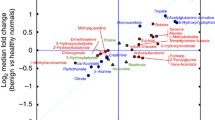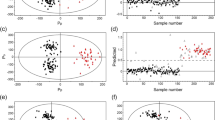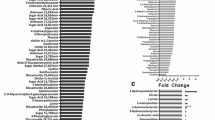Abstract
Background
Mass screening for gastric cancer (GC), particularly using endoscopy, may not be the most practical approach as a result of its high cost, lack of acceptance, and poor availability. Thus, novel markers that can be used in cost-effective diagnosis and noninvasive screening for GC are needed.
Methods
A total of 154 urine samples from GC patients and healthy individuals and 30 pairs of matched tumor and normal stomach tissues were collected. Multivariate analysis was performed on urinary and tissue metabolic profiles acquired using 1H nuclear magnetic resonance and 1H high-resolution magic angle spinning spectroscopy, respectively. In addition, metabolic profiling of urine from GC patients after curative surgery was performed.
Results
Multivariate statistical analysis showed significant separation in the urinary and tissue data of GC patients and healthy individuals. The metabolites altered in the urine of GC patients were related to amino acid and lipid metabolism, consistent with changes in GC tissue. In the external validation, the presence of GC (early or advanced) from the urine model was predicted with high accuracy, which showed much higher sensitivity than carbohydrate antigen 19-9 and carcinoembryonic antigen. Furthermore, 4-hydroxyphenylacetate, alanine, phenylacetylglycine, mannitol, glycolate, and arginine levels were significantly correlated with cancer T stage and, together with hypoxanthine level, showed a recovery tendency toward healthy controls in the postoperative samples compared to the preoperative samples.
Conclusions
An urinary metabolomics approach may be useful for the effective diagnosis of GC.



Similar content being viewed by others
References
Jemal A, Bray F, Center MM, et al. Global cancer statistics. CA Cancer J Clin. 2011;61:69–90.
Ono H, Kondo H, Gotoda T, et al. Endoscopic mucosal resection for treatment of early gastric cancer. Gut. 2001;48:225–9.
Jeong OH, Park YK. Clinicopathological features and surgical treatment of gastric cancer in South Korea: the results of 2009 nationwide survey on surgically treated gastric cancer patients. J Gastric Cancer. 2011;11:69–77.
Leung WK, Wu MS, Kakugawa Y, et al. Screening for gastric cancer in Asia: current evidence and practice. Lancet Oncol. 2008;9:279–87.
Hao Y, Yu Y, Wang L, et al. IPO-38 is identified as a novel serum biomarker of gastric cancer based on clinical proteomics technology. J Proteome Res. 2008;7:3668–77.
Chan DC, Chen CJ, Chu HC, et al. Evaluation of serum amyloid A as a biomarker for gastric cancer. Ann Surg Oncol. 2007;14:84–93.
Kang X, Zhang L, Sun J, et al. Prohibition: a potential biomarker for tissue-based detection of gastric cancer. J Gastroenterol. 2008;43:618–25.
Abbaszadegan MR, Moaven O, Sima HR, et al. p16 promoter hypermethylation: a useful serum marker for early detection of gastric cancer. World J Gastroenterol. 2008;14:2055–60.
Wu H, Xue R, Tang Z, et al. Metabolomic investigation of gastric cancer tissue using gas chromatography/mass spectrometry. Anal Bioanal Chem. 2010;396:1385–95.
Pasikanti KK, Esuvaranathan K, Ho PC, et al. Noninvasive urinary metabonomic diagnosis of human bladder cancer. J Proteome Res. 2010;9:2988–95.
Kim K, Aronov P, Zakharkin SO, et al. Urine metabolomics analysis for kidney cancer detection and biomarker discovery. Mol Cell Proteomics. 2009;8:558–70.
Qiu Y, Cai G, Su M, et al. Urinary metabonomic study on colorectal cancer. J Proteome Res. 2010;9:1627–34.
Slupsky CM, Steed H, Wells TH, et al. Urine metabolite analysis offers potential early diagnosis of ovarian and breast cancers. Clin Cancer Res. 2010;16:5835–41.
Yu L, Aa J, Xu J, et al. Metabolomic phenotype of gastric cancer and precancerous stages based on gas chromatography time-of-flight mass spectrometry. J Gastroenterol Hepatol. 2011;26:1290–7.
Ikeda A, Nishiumi S, Shinohara M, et al. Serum metabolomics as a novel diagnostic approach for gastrointestinal cancer. Biomed Chromatogr. 2012;26:548–58.
Hirayama A, Kami K, Sugimoto M, et al. Quantitative metabolome profiling of colon and stomach cancer microenvironment by capillary electrophoresis time-of-flight mass spectrometry. Cancer Res. 2009;69:4918–25.
Aa J, Yu L, Sun M, et al. Metabolic features of the tumor microenvironment of gastric cancer and the link to the systemic macroenvironment. Metabolomics. 2012;8:164–73.
Hu JD, Tang HQ, Zhang Q, et al. Prediction of gastric cancer metastasis through urinary metabolomic investigation using GC/MS. World J Gastroenterol. 2011;17:727–34.
Marrelli D, Roviello F, De Stefano A, et al. Prognostic significance of CEA, CA 19-9 and CA 72-4 preoperative serum levels in gastric carcinoma. Oncology. 1999;57:55–62.
Marrelli D, Pinto E, De Stefano A, et al. Clinical utility of CEA, CA 19-9, and CA 72-4 in the follow-up of patients with resectable gastric cancer. Am J Surg. 2001;181:16–9.
Kroemer G, Jaattela M. Lysosomes and autophagy in cell death control. Nat Rev Cancer. 2005;5:886–97.
Costello LC, Franklin RB. “Why do tumour cells glycolyse?” From glycolysis through citrate to lipogenesis. Mol Cell Biochem. 2005;280:1–8.
Tessem MB, Swanson MG, Keshari KR, et al. Evaluation of lactate and alanine as metabolic biomarkers of prostate cancer using 1H HR-MAS spectroscopy of biopsy tissues. Magn Reson Med. 2008;60:510–6.
Lind DS. Arginine and cancer. J Nutr. 2004;134:2837S–41S.
Leaf CD, Wishnok JS, Tannenbaum SR. l-Arginine is a precursor for nitrate biosynthesis in humans. Biochem Biophys Res Commun. 1989;163:1032–7.
McKnight GM, Duncan CW, Leifert C, et al. Dietary nitrate in man: friend or foe? Br J Nutr. 1999;81:349–58.
Goto T, Haruma K, Kitadai Y, et al. Enhanced expression of inducible nitric oxide synthase and nitrotyrosine in gastric mucosa of gastric cancer patients. Clin Cancer Res. 1999;5:1411–5.
Chan EC, Koh PK, Mal M, et al. Metabolic profiling of human colorectal cancer using high-resolution magic angle spinning nuclear magnetic resonance (HR-MAS NMR) spectroscopy and gas chromatography mass spectrometry (GC/MS). J Proteome Res. 2009;8:352–61.
Longnus SL, Wambolt RB, Barr RL, et al. Regulation of myocardial fatty acid oxidation by substrate supply. Am J Physiol Heart Circ Physiol. 2001;281:H1561–7.
Lysiak W, Toth PP, Suelter CH, et al. Quantitation of the efflux of acylcarnitines from rat heart, brain, and liver mitochondria. J Biol Chem. 1986;261:13698–703.
Lysiak W, Lilly K, DiLisa F, et al. Quantitation of the effect of l-carnitine on the levels of acid-soluble short-chain acyl-CoA and CoASH in rat heart and liver mitochondria. J Biol Chem. 1988;263:1151–6.
Fromm HJ, Hargrove M. Essentials of biochemistry. Berlin: Springer; 2012. p. 257–77.
Beevi Beevi SS, Rasheed MH, Geetha A. Evidence of oxidative and nitrosative stress in patients with cervical squamous cell carcinoma. Clin Chim Acta. 2007;375:119–23.
Kasapović J, Pejić S, Todorović A, et al. Antioxidant status and lipid peroxidation in the blood of breast cancer patients of different ages. Cell Biochem Funct. 2008;26:723–30.
Wu H, Xue R, Tang Z, et al. Metabolomic investigation of gastric cancer tissue using gas chromatography/mass spectrometry. Anal Bioanal Chem. 2010;396:1385–95.
Vannoni D, Porcelli B, Caldarone R, et al. Purine metabolism in human tumors. Medicina (Firenze). 1989;9:51–4.
Wu H, Xue R, Dong L, et al. Metabolomic profiling of human urine in hepatocellular carcinoma patients using gas chromatography/mass spectrometry. Anal Chim Acta. 2009;648:98–104.
Lindahl R, Petersen DR. Lipid aldehyde oxidation as a physiological role for class 3 aldehyde dehydrogenases. Biochem Pharmacol. 1991;41:1583–7.
Yoo BC, Kong SY, Jang SG, et al. Identification of hypoxanthine as a urine marker for non-Hodgkin lymphoma by low-mass-ion profiling. BMC Cancer. 2010;10:55.
Linder N, Haglund C, Lundin M, et al. Decreased xanthine oxidoreductase is a predictor of poor prognosis in early-stage gastric cancer. J Clin Pathol. 2006;59:965–71.
Acknowledgment
This work was supported by the National Research Foundation of Korea (NRF) funded by the Ministry of Science, ICT and Future Planning, Korea (2010-0024825, NRF-2010-0019394, 2013M3A9B6046418, and Creative Allied Project (CAP)), the Korea Institute of Oriental Medicine (K14281), and the Korea Basic Science Institute (T33409).
Disclosure
The authors declare no conflict of interest.
Author information
Authors and Affiliations
Corresponding authors
Electronic supplementary material
Below is the link to the electronic supplementary material.
Rights and permissions
About this article
Cite this article
Jung, J., Jung, Y., Bang, E.J. et al. Noninvasive Diagnosis and Evaluation of Curative Surgery for Gastric Cancer by Using NMR-based Metabolomic Profiling. Ann Surg Oncol 21 (Suppl 4), 736–742 (2014). https://doi.org/10.1245/s10434-014-3886-0
Received:
Published:
Issue Date:
DOI: https://doi.org/10.1245/s10434-014-3886-0




